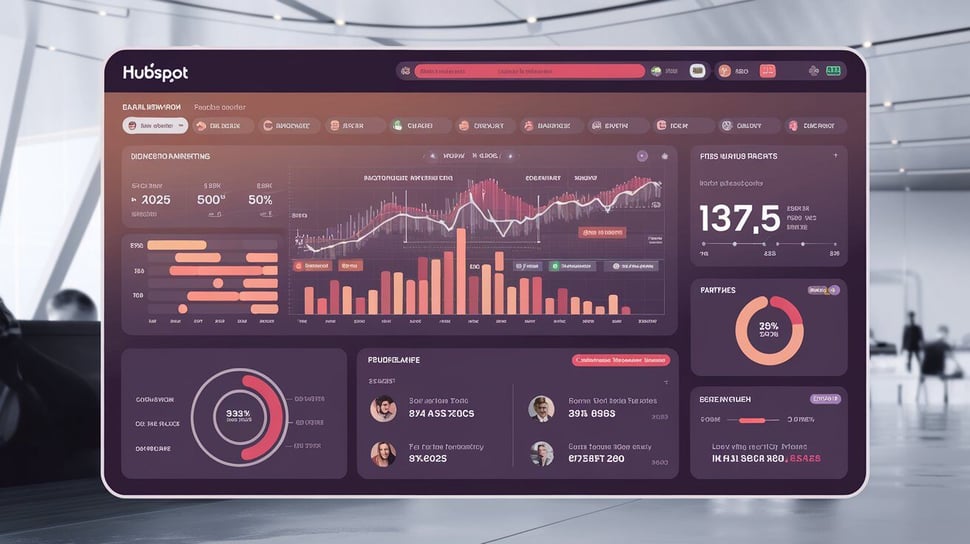
Blog Details
Marketing Analytics Reports in HubSpot: How to Track and Improve Performance
- March 17 2025
- Nikias Kray

Marketing Analytics Reports in HubSpot
Understanding your marketing performance is essential for business growth. HubSpot provides powerful marketing analytics reports that help businesses track, measure, and optimize their marketing efforts effectively. In this guide, we’ll explore the key marketing analytics reports available in HubSpot and how they can benefit your business.
1. Traffic Analytics: Monitor Website Traffic Sources
Traffic analytics in HubSpot helps businesses understand where their website visitors are coming from, which channels drive the most traffic, and how users interact with their site.
Data Sources:
-
Organic search (Google, Bing, etc.)
-
Paid search campaigns (Google Ads, Bing Ads)
-
Social media platforms (Facebook, LinkedIn, Twitter, Instagram)
-
Referral traffic from third-party sites
-
Direct traffic (users entering the website URL directly)
-
Email marketing campaigns
How It Works:
HubSpot’s Traffic Analytics dashboard provides a breakdown of traffic by source, device type, and user behavior. By analyzing this data, marketers can identify which channels are driving the most qualified leads and adjust their strategies accordingly.
Business Benefits:
-
Identify top-performing marketing channels.
-
Optimize ad spend based on traffic quality.
-
Improve website user experience based on visitor behavior.
2. Lead Generation Metrics: Tracking Forms, Landing Pages, and Conversion Rates
Generating and converting leads is at the core of any marketing strategy. HubSpot’s lead generation reports provide insights into how well landing pages, forms, and calls-to-action (CTAs) are performing.
Data Sources:
-
Form submissions
-
CTA clicks and conversions
-
Landing page performance
-
Multi-step lead generation funnels
-
CRM data on lead movement through sales stages
How It Works:
Marketers can set up custom dashboards in HubSpot to track lead conversion rates, form submissions, and engagement levels. A/B testing can also be conducted to improve conversion rates.
Business Benefits:
-
Improve landing page design for better conversions.
-
Identify bottlenecks in the lead generation process.
-
Align marketing and sales teams with accurate lead tracking.
3. Email Campaign Performance: Open Rates, Click-Throughs, and Engagement
Email marketing remains a powerful tool for nurturing leads and engaging customers. HubSpot provides detailed email campaign performance reports that help marketers optimize their email outreach.
Data Sources:
-
Open rates and click-through rates (CTR)
-
Bounce rates and unsubscribe rates
-
Engagement metrics (time spent on email, link clicks, etc.)
-
Automated email workflow performance
-
Email segmentation performance
How It Works:
HubSpot tracks email interactions and provides insights on recipient behavior. It also allows marketers to conduct A/B testing and segment email lists for targeted campaigns.
Business Benefits:
-
Increase email engagement with targeted content.
-
Reduce email bounce rates and spam complaints.
-
Improve overall email marketing ROI.
4. Social Media Analytics: Measuring Engagement and Reach
Social media plays a crucial role in brand awareness and customer engagement. HubSpot’s social media reports help businesses track performance across different platforms.
Data Sources:
-
Engagement metrics (likes, shares, comments)
-
Follower growth over time
-
Click-through rates on social media posts
-
Best-performing content
-
Paid social ad performance
How It Works:
HubSpot integrates with major social media platforms, allowing marketers to track their performance in real-time. Reports can be generated to compare organic vs. paid social media efforts.
Business Benefits:
-
Optimize content strategy based on engagement metrics.
-
Allocate social media budgets efficiently.
-
Increase audience reach with data-driven insights.
5. ROI and Revenue Attribution: Measuring Marketing Impact on Sales
Understanding how marketing efforts contribute to revenue is critical for decision-making. HubSpot provides revenue attribution reports that connect marketing activities with actual sales outcomes.
Data Sources:
-
Marketing campaign data
-
CRM sales pipeline data
-
Multi-touch attribution models
-
Customer journey mapping
-
ROI calculations based on campaign costs and revenue
How It Works:
HubSpot’s attribution models help businesses track the customer journey and identify which marketing touchpoints contribute to conversions.
Business Benefits:
-
Justify marketing spend with clear ROI reports.
-
Optimize campaigns based on revenue generation.
-
Improve alignment between marketing and sales teams.
Conclusion
HubSpot’s marketing analytics reports provide businesses with valuable insights into website traffic, lead generation, email performance, social media engagement, and revenue attribution. By leveraging these reports, marketers can make data-driven decisions that improve their strategies, optimize budgets, and drive sustainable business growth.
Looking to enhance your marketing analytics with HubSpot? Start leveraging these reports today to make smarter marketing decisions!

Leave your thought here
Your email address will not be published. Required fields are marked *